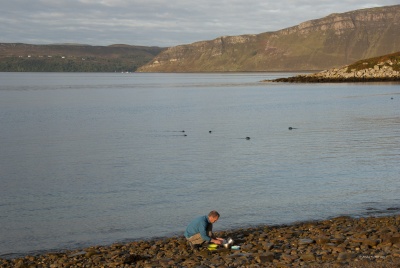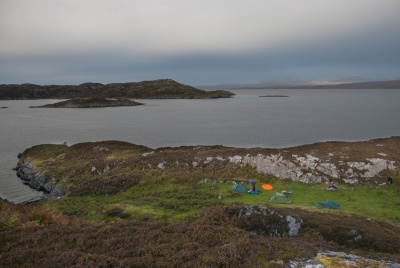Hebrides Camping Trip, September 2017
Wild Camping In Scotland: September 2017
By Andy Garbett
“How do you fancy a wild camping trip to Scotland?” This question, posed on a Tuesday evening paddle towards Westminster, was easy to answer in the affirmative given the expectation that such an event would never materialise. That it would be discussed enthusiastically in The Prospect of Whitby and then disappear down a black hole of busy lives. But I had not counted on the persistence of my fellow Andys and a few months later I, a man with a visceral aversion to life in the wild, was held to my word and was travelling northwards to Glencoe. Help!
We stayed at The Red Squirrel Campsite before driving the next morning, one of us still feeling the effects of overindulgence at the Clachaig Public House, to Sconcer on the Isle of Skye.
By early afternoon we had packed our boats with camping gear plus food and water for a week and set off from the slipway at Sconcer with the initial aim of circumnavigating the Islands of Raasay and Rona. We decided not to take advantage of the tidal flow towards the east but to go north through the Narrows of Raasay and paddle along the west coast of the island. Landing and camping opportunities are limited in this area and we had identified a good spot that we could reach before nightfall. However, the expected south-westerly wind had turned from light to moderate and now blew perversely into our faces from the north. An easy paddle to our first base had become more difficult and, with the prospect of fading light, we curtailed our journey at Holoman Bay where we were fortunately able to set up camp.
Drift wood was found, a fire established and before very long a Malaysian chicken curry was being washed down with a couple of glasses (*2) of shiraz from the wine bag that seemed to have been perfectly designed to fit into the far extremity of my front hatch. And as the fading embers flickered and the Milky Way lit up in the firmament so I began to warm to this wild camping lark.
(*2) Andy Nutter is a man for all seasons. He was able to produce both wine and whisky glasses from seemingly bottomless hatches which also carried an array of cooking equipment. His experience in wild camping and the outdoor life proved a godsend.
We set off the next morning on a calm sea and with a determination to enjoy the paddle to our next overnight stop that lay towards the northern tip of Raasay and within sight of Rona. We took time to explore the coastline and were often accompanied by common and, later, grey seals. Andy Nutter provided fishing lines but we were in competition with an extraordinary number of cormorants and had to wait a couple more days before enjoying freshly caught mackerel lightly cooked over a wood fire.
The next day, our fourth out of London, we crossed Caol Rona in benign conditions and began to paddle along the western coastline of the smaller island of Rona. Again the emphasis was upon enjoying the environment, the sea and the topography, rather than racing towards a finishing line. So we took our time over a six mile journey to Loch a bhraige where Charlie Skrine had stayed the previous year with friends. But Charlie’s beach was now occupied by grey seals and their pups and so we sought refuge further along the sea loch where camping conditions proved more difficult.
Loch a' Bhraige is best described as a large, sheltered bay and it provides a natural harbour for a NATO station which is overlooked in the middle distance by the beautiful Rona lighthouse. The proximity of a secretive military establishment slightly unnerved me and I became worryingly susceptible to tricks played by the rising tide and the fading light. A good night’s sleep, or therapy, was required but for me, as a camping novitiate, it was usually difficult to achieve.
The morning of the fifth day was probably the highlight of our trip. The northern tip of Rona is a collection of skerries and inlets that provide the perfect habitat for the seals that constantly appeared: as curious to see us as we were them. The sea and weather conditions were perfect and we took advantage to explore, to fish or simply absorb and enjoy our surroundings. Kayaking perfection!
We had planned to paddle to the site of the ruined Brochel castle that lies almost halfway along the eastern coast of Raasay but, after completing the circumnavigation of Rona, we decided quite spontaneously to head for the Scottish mainland. The six mile journey was achieved in quick time but we arrived in Applecross Bay at low tide and faced the arduous task of carrying our boats some distance over a rocky beach and then hauling them up a long and steep incline to the security of a designated campsite. This episode, compounded by the onset of heavy rain, might have disheartened us but a hot shower, a bite to eat and a couple of pints at the local pub did wonders for both body and soul. Roll on tomorrow!
The limpid coastal waters south of Applecross revealed an abundance of marine life including sea urchins and star fish. We were also surprised to see, at a distance, a pod of dolphins/porpoises: closely followed by a submarine!
We reached the uninhabited Crowlin Islands (*4) and then spent time in finding a suitable camping spot. Faced with an inhospitable landscape it was not an easy task but we eventually cleared away rocks and stones and managed to pitch three tents beside a small stream. This was the last night on our voyage and the next morning we kayaked towards Skye.
The plan was to head for the island of Longay (*5) before hugging the north-western coast of
Scalpay and then paddling through Caol Mor (*6) to reach Sconcer. But the weather had taken
a turn for the worse and the wind had noticeably picked up. We decided that the first stage
of the proposed course was within our capabilities but that we would have to reassess our
strategy if the sea conditions had deteriorated by the time that we reached Longay.
Mercifully we met much calmer water on the leeward side of the island and the rest of our passage was uneventful.
We arrived at Sconcer in tandem with the Skye-Raasay ferry from which a handful of cars and a single foot passenger emerged. Do you think they had as much fun as us?


















